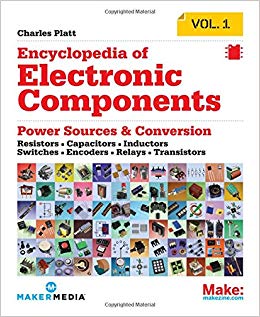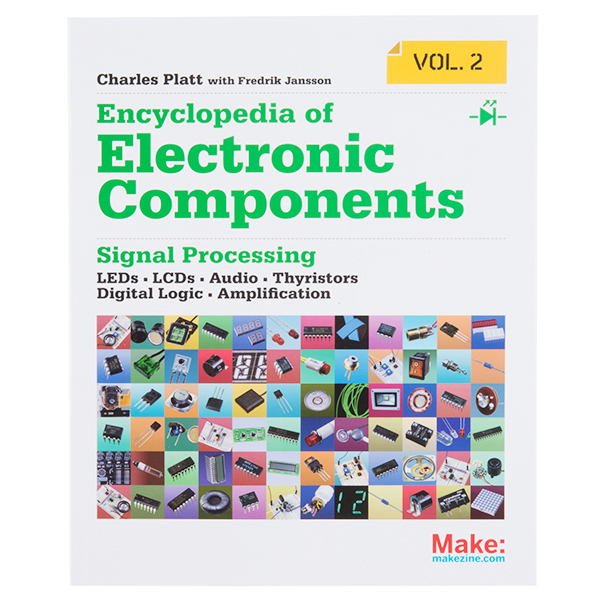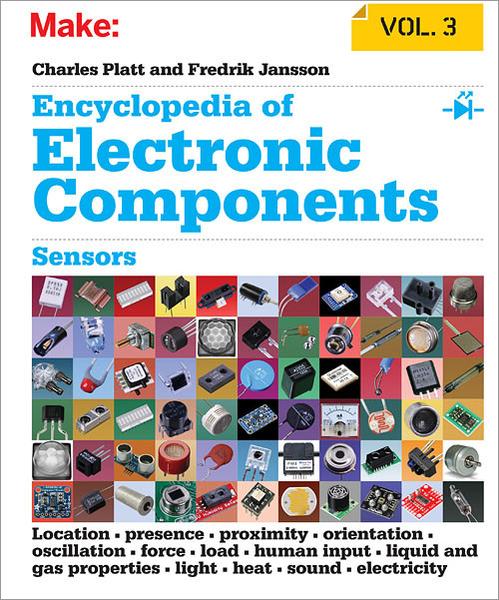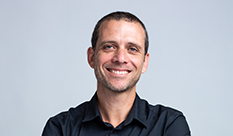עוד בפרק זה:
אוגוסט 2019
הספרייה מציעה לקוראיה מידי חודש רשימת ספרים וכתבי-עת חדשים שנוספו לאוספיה כל רשומה מכילה:
מס' מיון, מחבר, כותר, מוציא לאור, שנת הוצאה , נושאים, מס' מערכת תוכן עיניינים ותקציר.
כדי לראות מצב ההשאלות יש ללחוץ על כותר.
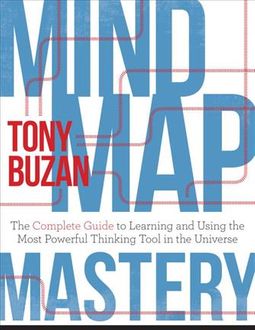 |
159.9 BUZ Buzan, Tony London : Watkins, an imprint of Watkins Media Limited, [2018]. Contents 1.What Is a Mind Map? -- 2.How to Mind Map -- 3.What Is Not a Mind Map? -- 4.Solution Finding -- 5.The Infinite Applications of Mind Maps -- 6.The Future of Mind Mapping. Abstract For the past five decades, Tony Buzan has been at the leading edge of learning and educational research with his revolutionary Mind Map technique. With Mind Map Mastery, he has distilled these years of global research into the clearest and most powerful instructional work available on the Mind Map technique. "I would recommend Tony’s new book to anybody who wants to improve their thinking and achieve Mind Map mastery themselves." – Dominic O’Brien, eight-time World Memory Champion and bestselling authorTony Buzan invented the Mind Map technique five decades ago. Seeing the transformational impact it had on people, he has been spreading the thinking tool across the world ever since. Tony Buzan’s Mind Map technique has gathered amazing praise and an enormous worldwide following over the last few decades, but as with any very successful idea, there have been many sub-standard imitators. With Mind Map Mastery, Tony Buzan re-establishes the essential concepts that are the core of the Mind Map with a clarity and practicality unrivalled by other books. If you are looking to improve your memory, plan your business strategy, become more organized, study for an exam or plan out your future, this is the book for you. With a clarity and depth that far exceeds any other book on the subject, it includes the history of the development of the Mind Map, an explanation of what makes a Mind Map (and what isn’t a Mind Map) and why it’s such a powerful tool, illustrated step-by-step techniques for Mind Map development – from simple to complex applications – and how to deal with Mind Maps that have “gone wrong”. Developed both for those new to the Mind Map concept as well as more experienced users who would like to revise and expand their expertise, Mind Map Mastery is the one Mind Mapping book needed on the shelf of every student and business person across the world. Subject Intellect Brain Thought and thinking Study skills Creative ability Creative thinking Memory Cognition 42905
|
 |
159.9.019.25 מיי מיינדפולנס : להיות כאן ועכשיו : תרגול, הגות ויישומים מושב בן שמן : כתר, 2018. Contents פרק ראשון: הגדרת המיינדפולנס -- פרק שני: שורשי המיינדפולנס בהגות הבודהיסטית -- פרק שלישי: מיינדפולנס וחמלה עצמית -- פרק רביעי: כיצד זה עובד? מקשב פשוט לתהליך שינוי מעמיק -- פרק חמישי: המסע מהעצמי אל המרחב: אופק המיינדפולנס -- פרק שישי: לא לפחד מהפחד - תרפיה מבוססת קשיבות לטיפול בחרדה -- פרק שביעי: להשתחרר מכבלי הייאוש - מיינדפולנס לטיפול בדיכאון -- פרק שמיני: תקשורת קשובה - מיינדפולנס בשדה הקשר -- פרק תשיעי: "קריאה לנתינה אכפתית" - חינוך קשוב, אכפתי ואתי -- פרק עשירי: מיינדפולנס, מדע ומוח -- פרק אחד-עשר: מיינדפולנס ופסיכואנליזה - המרחב הטיפולי כהתהוות קשובה Abstract "מהו תרגול מיינדפולנס? כיצד הבאת קשב פתוח וסקרן אל החוויה שלנו, ממש עכשיו, יכולה להוביל אותנו אל שבילי חיים חדשים, פתוחים וגמישים, להרגיע חרדה, להפחית דיכאון, לשפר קשב וריכוז ולעורר חמלה? ומדוע בעולם המערבי לא מפסיקים לדבר על הנושא, שהפך לפופולרי כמו מזון מהיר, מעין מק’מיינדפולנס? מיינדפולנס נועד לסייע לנו ביצירת מרחב התבוננות בהווה ובתודעה, מרגע לרגע, באופן מכוון ובלתי שיפוטי. מחקרים מדעיים רבים מוכיחים את יעילותו. ועם זאת, מיינדפולנס אינו מציע פתרון קסם, אלא מסע תודעתי לנופים יפים וקשים גם יחד. במהלכו מתברר לנו עד כמה ההווה חומק מאיתנו במחשבות על העבר וציפיות לעתיד. ההתבוננות הזו בנתיבי חיינו המוכרים מולידה הבזקים של חופש, פתיחות, יציבות ושחרור מהרגלים מכאיבים. מיינדפולנס – להיות כאן ועכשיו הינו ספר מקיף, שתחילתו בשורשים הבודהיסטיים של התרגול והמשכו במיפוי שלל יישומיו בהווה, בהם חקר המוח, חינוך קשוב ושיפור יחסים עם הזולת. הספר מיועד למתחילים ולמבקשים להעמיק. הוא מכיל ידע תיאורטי לצד שלל תרגילים פשוטים וייחודיים שניתן לתרגל בבית." Subject Psychotherapy Meditation Meditation -- Therapeutic use. Mindfulness-based cognitive therapy Self-help techniques Buddhism -- Psychology Meditation -- Psychological aspects. Mind and body therapies 42848
|
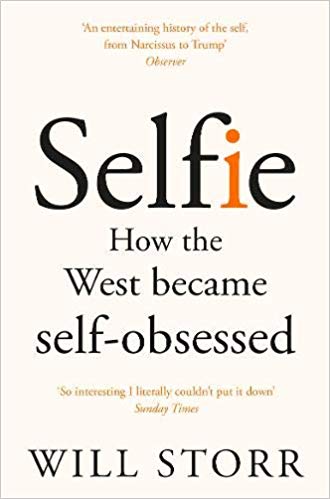 |
159.923.2 STO Storr, Will Selfie : how the west became self-obsessed London : Picador, [2018]. Contents The dying self -- The tribal self -- The perfectible self -- The bad self -- The good self -- The special self -- The digital self -- How to stay alive in the age of perfectionism Abstract We live in an age of perfectionism. Every day, we’re bombarded with the beautiful, successful, slim, socially-conscious and extroverted individual that our culture has decided is the perfect self. We see this person constantly in shop windows, in newspapers, on the television, at the movies and all over our social media. We berate ourselves when we don’t match up to them - when we’re too fat, too old, too poor or too sad. This cycle can be extremely bad for us. In recent years, psychologists have even begun to think that many people take their own lives because of the impossible standards that are set for who they ought to be.Will Storr began to wonder about this perfect self that torments so many of us. Who, actually, is this person? Why does it hold such power over us? Could it be humanity’s deadliest idea? And, if so, is there any way we can break its spell?To find out, Storr takes us on a journey from the shores of Ancient Greece, through the Christian Middle Ages, the encounter groups of 1960s California and self-esteem evangelists of the late twentieth century to modern-day America, where research suggests today’s young people are in the grip of an epidemic of narcissism. He’ll tell the strange story of the individualist Western self from its birth on the Aegean to the era of hyper-individualistic neoliberalism in which we find ourselves today. "Selfie" reveals, for the first time, the epic tale of the person we all know so intimately . . . because it’s us. Subject Self Self -- History. Self-perception 42896
|
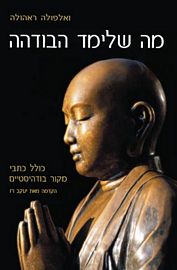 |
24 ואל ואלפולה, ראהולה ירושלים : כתר, [תשס"ד] 2004. Abstract איש רגיל היה שאקימוני, זה שאנו מכנים הבודהה, זה שהתעורר. שאלה אחת בערה בו: מאין האי-נחת שנוכחת בכול, ואיך אפשר להקל או להיחלץ מהאי-נחת? תעתוע, התעלמות, עיוורון וידיעה שגויה מביאים לסבל, אי-נחת, תסכול ומצוקה. כך הבין שאקימוני כשהתעורר מן התעתוע. הוא יצא לדרך החיפוש מתוך ויתור על ממלכה, וגילה את הוויתור כנקודת מוצא לריפוי. הוא יצא למסע החיפוש מתוך חמלה לכל היצורים שראה אותם בסבלם, וגילה גם את החמלה כנקודת מוצא לריפוי. הוא הבין את הדרך כשהיה בהתבוננות עמוקה והציע את דרך ההתבוננות כמוצא אפשרי לסבל. את תחילתה ואת סופה של הדרך אפשר לסכם במשפט אחד: הדרך לשחרור מתחילה בראיית הדברים כמות שהם. לא יותר. לא פחות. האם זו דת? פילוסופיה? פסיכותרפיה? כל אלה? אף לא אחד מהם? הכול תלוי בהגדרה, כמובן. נזכור נא שהמונחים הללו באים כולם מסביבה מערבית, ולכן השאלות מבקשות תשובה מערבית. מכאן אולי הבודהיזם הוא הכול. מעין תורה מאוחדת. - כריכה אחורית Per.Sub. Gautama Buddha Subject Buddhism Buddhism -- Doctrines 42847
|
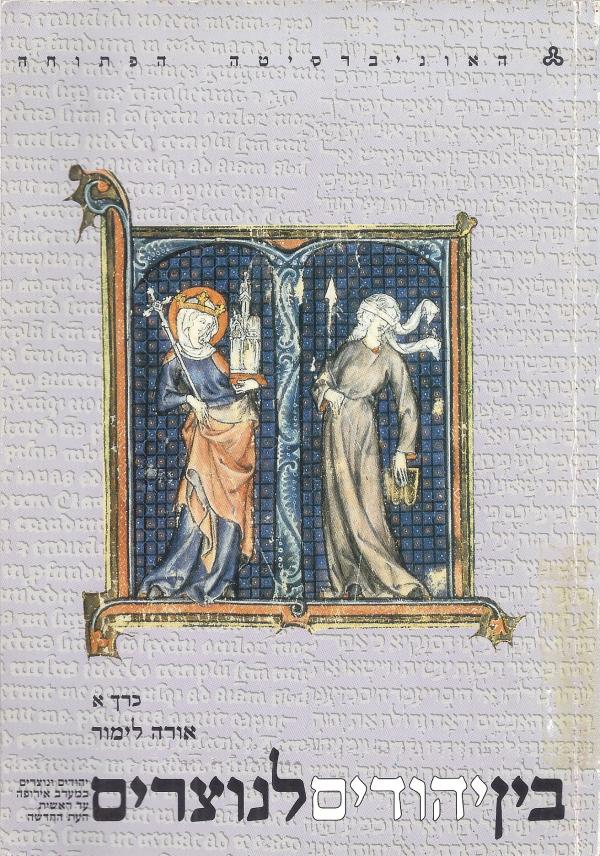 |
261.1 בין בין יהודים לנוצרים : יהודים ונוצרים במערב אירופה עד ראשית העת החדשה / כרך ד’ - מהדורה שנייה ומעודכנת רעננה : האוניברסיטה הפתוחה, תשנ"ג-תשנ"ג 1993-2017 Contents כרך א: יחידה 1. יעקב ועשיו / אורה לימור כרך ב: יחידה 2. רוב ומיעוט / אמנון רז-קרקוצקין, אורה לימור -- כרך ב: יחידה 3 . דמיון ושוני / אורה לימור -- כרך ב, יחידה 4. יהודים בבית המשפט הנוצרי : דיון בשבועת היהודים / יוסף ציגלר כרך ג: יחידה 5. הוויכוח בין יהודים לנוצרים / אורה לימור כרך ד: יחידה 6. האמת העברית / אורה לימור, אמנון רז-קרקוצקין -- כרך ד: יחידה 7. אמונה ותבונה / יוסף ציגלר כרך ה, יחידה 9. עלילת הדם / אורה לימור -- כרך ה, יחידה 10. האנוסים / יוסף קפלן -- כרך ה, יחידה 11. יהודים ונוצרים בעת הרפורמציה / עמוס הופמן Per.Sub. Maimonides, Moses, 1135-1204 Title Sub. Bible -- Criticism, interpretation, etc. Subject Christianity and other religions -- Judaism Judaism -- Relations -- Christianity. Jews -- Europe -- History -- 70-1789 Civilization, Medieval 42923
|
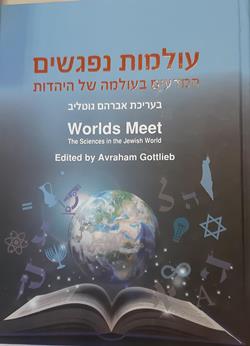 |
296:5 עול עולמות נפגשים : המדעים בעולמה של היהדות רמת-גן : ביה"ס ללימודי יסוד ביהדות, ע"ש הלנה ופאול שולמן, אוניברסיטת בר-אילן, [2017 בערך] Subject Judaism and science Science Science -- Israel. Earth sciences 42914
|
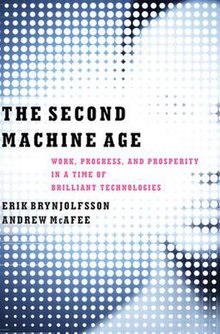 |
316.422 BRY Erik Brynjolfsson, Andrew McAfee. The second machine age : work, progress, and prosperity in a time of brilliant technologies New York : W. W. Norton & Company, 2016. Contents The big stories -- The skills of the new machines: technology races ahead -- Moore’s law and the second half of the chessboard -- The digitization of just about everything -- Innovation: declining or recombining? -- Artificial and human intelligence in the second machine age -- Computing bounty -- Beyond GDP -- The spread -- The biggest winners: stars and superstars -- Implications of the bounty and the spread -- Learning to race with machines: recommendations for individuals -- Policy recommendations -- Long-term recommendations -- Technology and the future (which is very different from "Technology is the future"). Abstract Crystallized the debate over the pace of technological change and its effect on the economy, vaulting onto best-seller lists with its whip-smart explanation of the forces behind everything from Jeopardy!-champion computers to self-driving cars. Subject Information technology -- Economic aspects. Economic development -- Technological innovations. Progress -- Social aspects. Social classes 42880
|
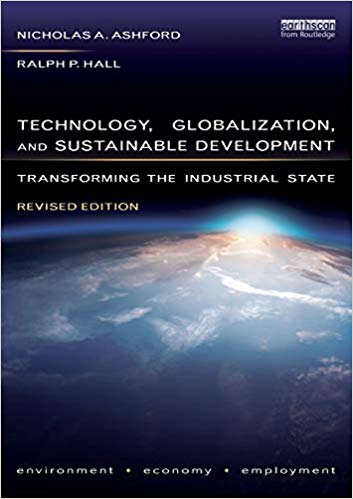 |
330.34 ASH Nicholas A. Ashford and Ralph P. Hall. Technology, globalization, and sustainable development / Revised edition. London ; New York : Routledge, an imprint of the Taylor & Francis Group [2019]. Abstract Technology, Globalization, and Sustainable Development offers a unified, transdisciplinary approach for transforming the industrial state in order to promote sustainable development. The authors present a deep analysis of the ways that industrial states – both developed and developing – are currently unsustainable and how economic and social welfare are related to the environment, to public health and safety, and to earning capacity and meaningful and rewarding employment. The authors offer multipurpose solutions to the sustainability challenge that integrate industrial development, employment, technology, environment, national and international law, trade, finance, and public and worker health and safety. The authors present a compelling wake-up call that warns of the collision course set between the current paths of continued growth and inevitable unsustainability in the world today. Offering clear examples and real solutions, this textbook illustrates how the driving forces that are currently promoting unsustainability can be refocused and redesigned to reverse course and improve the state of the world. This book is essential reading for those teaching and studying sustainable development and the critical roles of the economy, employment, and the environment. Subject Sustainable development -- Developing countries. Sustainable development -- Developing countries. Technology Globalization 42877
|
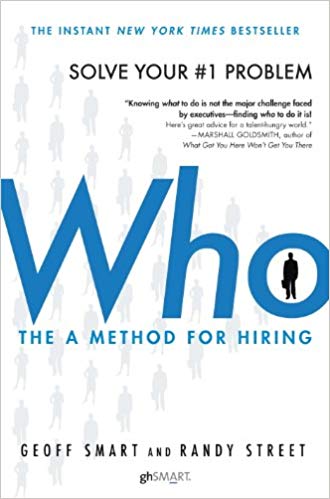 |
331.108.37 SMA Geoff Smart and Randy Street. New York : Ballantine Books, [2008]. Contents Your #1 problem -- Scorecard : a blueprint for success -- Source : generating a flow of A players -- Select : the four interviews for spotting A players -- Sell : the top five ways to seal the deal -- Your greatest opportunity. Abstract In this instant New York Times Bestseller, Geoff Smart and Randy Street provide a simple, practical, and effective solution to what The Economist calls “the single biggest problem in business today”: unsuccessful hiring. The average hiring mistake costs a company $1.5 million or more a year and countless wasted hours. This statistic becomes even more startling when you consider that the typical hiring success rate of managers is only 50 percent. The silver lining is that “who” problems are easily preventable. Based on more than 1,300 hours of interviews with more than 20 billionaires and 300 CEOs, Who presents Smart and Street’s A Method for Hiring. Refined through the largest research study of its kind ever undertaken, the A Method stresses fundamental elements that anyone can implement–and it has a 90 percent success rate. Whether you’re a member of a board of directors looking for a new CEO, the owner of a small business searching for the right people to make your company grow, or a parent in need of a new babysitter, it’s all about Who. Inside you’ll learn how to • avoid common “voodoo hiring” methods • define the outcomes you seek • generate a flow of A Players to your team–by implementing the #1 tactic used by successful businesspeople • ask the right interview questions to dramatically improve your ability to quickly distinguish an A Player from a B or C candidate • attract the person you want to hire, by emphasizing the points the candidate cares about most In business, you are who you hire. In Who, Geoff Smart and Randy Street offer simple, easy-to-follow steps that will put the right people in place for optimal success. Subject Employee selection Employees -- Recruiting. Employment interviewing 42861
|
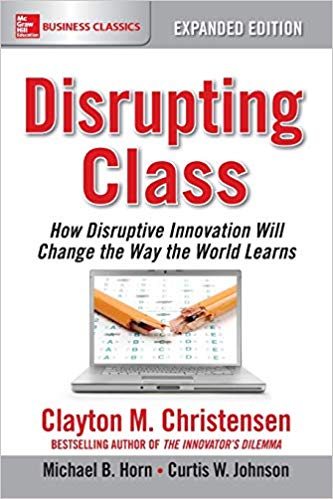 |
37.014.35 CHR Clayton M. Christensen, Michael B. Horn and Curtis W. Johnson. Disrupting class : how disruptive innovation will change the way the world learns. New York : McGraw-Hill Education, [2017]. Contents Randall Circle High School -- Why schools struggle to teach differently when each student learns differently -- Making the shift : schools meet society’s jobs -- Crammed classroom computers -- Disruptively deploying computers -- The system for student-centric learning -- The impact of the earliest years on students’ success -- Why so many students seem unmotivated -- Improving education research -- Organizing to innovate. Abstract A brilliant teacher, Christensen brings clarity to a muddled and chaotic world of education.” ―Jim Collins, bestselling author of Good to Great “A terrific read; it must become a blueprint for educational transformation.” ―Joel Klein, former Chancellor of the New York City Department of Education Studies in neuroscience reveal that the way we learn doesn’t always match up with the way we are taught. To stay competitive―academically, economically, and technologically―we need to apply the proven principles of disruptive innovation to our educational system. Disrupting Class will show you how to: • Help more students succeed through customized learning • Meet the demand for new technology, especially computers, in student-centric classrooms • Use disruptive innovation to circumvent roadblocks that have stood in the way of reform • Compete in the global classroom―and help students get ahead in the global market Filled with fresh and surprising ideas, outside-the-box strategies, and straight-A success stories, Disrupting Class will make you rethink your understanding of intelligence, reevaluate your current school program, and reinvigorate your commitment to learning. The future is now. Class is in session. Subject Educational innovations Education -- Effect of technological innovations on. Multiple intelligences. Learning, Psychology of 42876
|
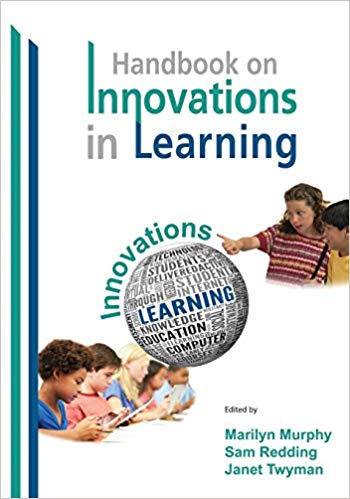 |
37.014.35 HAN The handbook on innovations in learning Charlotte, NC : Information Age Publishing Inc., [2014]. Contents Foreword and overview / Marilyn Murphy -- What is an innovation in learning? / Sam Redding, Janet S. Twyman, and Marilyn Murphy -- Stimulating innovation (or making innovation meaningful again) / Maureen M. Mirabito and T.V. Joe Layng -- Innovation, implementation science, and data-based decision making: components of successful reform / Ronnie Detrich -- The logic of school improvement, turnaround, and innovation / Sam Redding -- Innovative practice in teaching the English language arts: building bridges between literacy in school and out / Michael W. Smith -- Innovations in language and literacy instruction / Michael L. Kamil -- Specialized innovations for students with disabilities / Joseph R. Boyle -- Getting personal: the promise of personalized learning / Sam Redding -- Education + technology + innovation = learning? / T.V. Joe Layng and Janet S. Twyman -- Games in learning, design, and motivation / Catherine C. Schifter -- Advances in online learning / Herbert J. Walberg and Janet S. Twyman -- Learning, schooling, and data analytics / Ryan S.J.d. Baker -- Idaho leads: applying learning in and out of the classroom to systems reform / Lisa Kinnaman -- Using response to intervention data to advance learning outcomes / Amanda M. VanDerHeyden -- Innovation in career and technical education methodology / Mark Williams. Abstract An innovation in learning improves upon the implementation of the standard practice or introduces a new practice, thus achieving greater learning outcomes. The Handbook on Innovations in Learning, developed by the Center on Innovations in Learning, presents commissioned chapters describing current best practices of instruction before embarking on descriptions of selected innovative practices which promise better methods of engaging and teaching students. Written by a diverse and talented field of experts, chapters in the Handbook seek to facilitate the adoption of the innovative practices they describe by suggesting implementation policies and procedures to leaders of state and local education agencies. Subject Educational innovations Learning, Psychology of Effective teaching School improvement programs 42883
|
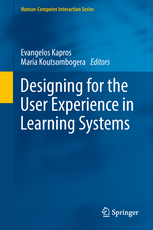 |
371.31 DES Designing for the user experience in learning systems Cham, Switzerland : Springer, [2018]. Contents Introduction: User Experience in and for Learning -- Part I. Foundations, Frameworks, Principles. Education, Technology and Design: A Much Needed Interdisciplinary Collaboration ; A Universally Accessible Self-assessment Gamified Framework and Software Application to Capture 21st Century Skills ; Designing Pedagogy for Virtual Worlds in Multicultural Environments ; The CHI of Teaching Online: Blurring the Lines Between User Interfaces and Learner Interfaces -- Part II. Applications and Case Studies. User Requirements When Designing Learning e-Content: Interaction for All ; iMuSciCA: Interactive Music Science Collaborative Activities for STEAM Learning ; A Case Study of Peer Feedback as a Continuous Assessment Tool for Transversal Competencies ; Constructive Learning by Teaching: Flip-Flop, Peer Evaluation, and Agile Tooltip: Making and Taking Peer Quizzes Synchronized with Lecture Screencasts ; Using Animation to Enrich Learning Experience in Sketch-Based Physics Tutoring Systems -- Appendix A: SkillTrack! Trial Details and Evaluation. Abstract While the focus of the UX research and design discipline and the Learning Sciences and instructional design disciplines is often similar and almost always tangential, there seems to exist a gap, i.e. a lack of communication between the two fields. Not much has been said about how UX Design can work hand-in-hand with instructional design to advance learning. The goal of this book is to bridge this gap by presenting work that cuts through both fields. To illustrate this gap in more detail, we provide a combined view of UX Research and Design & Educational Technology. While the traditional view has perceived the Learning Experience Design as a field of Instructional Design, we will highlight its connection with UX, an aspect that has become increasingly relevant. Our focus on user experience research and design has a unique emphasis on the human learning experience: we strongly believe that in learning technology the technological part is only mediating the learning experience, and we do not focus on technological advancements per se, as we believe they are not the solution, in themselves, to the problems that education is facing. This book aims to lay out the challenges and opportunities in this field and highlight them through research presented in the various chapters. Thus, it presents a unique opportunity to represent areas of learning technology that go very far beyond the MOOC and the classroom technology. The book provides an outstanding overview and insights in the area and it aims to serve as a significant and valuable source for learning researchers and practitioners. The chapter "User requirements when designing learning e-content: interaction for all" is available open access under a CC BY 4.0 license at link.springer.com Subject Instructional systems -- Design. Instructional systems Learning -- Technological innovations. 42873
|
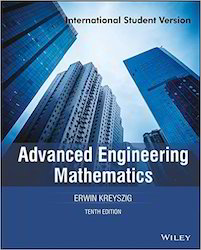 |
TB_51-74 KRE Erwin Kreyszig ; in collaboration with Herbert Kreyszig, Edward J. Norminton. Advanced engineering mathematics / Tenth edition, International student version. Hoboken, New Jersey : Wiley, [2011]. Abstract The tenth edition of this bestselling text includes examples in more detail and more applied exercises; both changes are aimed at making the material more relevant and accessible to readers. Kreyszig introduces engineers and computer scientists to advanced math topics as they relate to practical problems. It goes into the following topics at great depth differential equations, partial differential equations, Fourier analysis, vector analysis, complex analysis, and linear algebra/differential equations. Subject Mathematical physics Engineering mathematics 42915
|
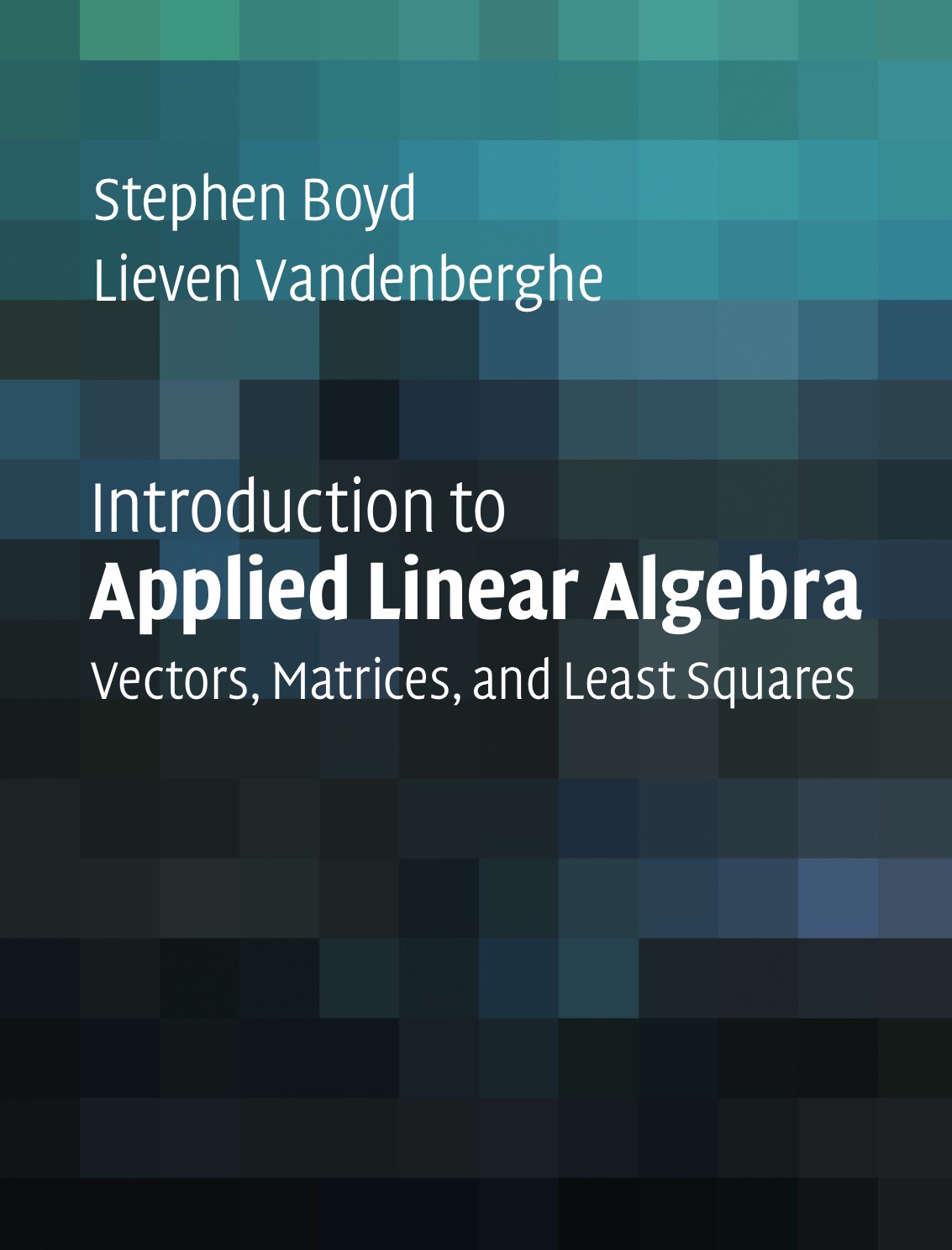 |
512.8 BOY Stephen Boyd, Lieven Vandenberghe. Introduction to applied linear algebra : vectors, matrices, and least squares Cambridge : Cambridge University Press, [2018]. Contents Vectors -- Linear functions -- Norm and distance -- Clustering -- Linear independence -- Matrices -- Matrix examples -- Linear equations -- Linear dynamical systems -- Matrix multiplication -- Matrix inverses -- Least squares -- Least squares data fitting -- Least squares classification -- Multi-objective least squares -- Constrained least squares -- Constrained least squares applications -- Nonlinear least squares -- Constrained nonlinear least squares. Abstract This groundbreaking textbook combines straightforward explanations with a wealth of practical examples to offer an innovative approach to teaching linear algebra. Requiring no prior knowledge of the subject, it covers the aspects of linear algebra - vectors, matrices, and least squares - that are needed for engineering applications, discussing examples across data science, machine learning and artificial intelligence, signal and image processing, tomography, navigation, control, and finance. The numerous practical exercises throughout allow students to test their understanding and translate their knowledge into solving real-world problems, with lecture slides, additional computational exercises in Julia and MATLAB®, and data sets accompanying the book online. Suitable for both one-semester and one-quarter courses, as well as self-study, this self-contained text provides beginning students with the foundation they need to progress to more advanced study. Subject Algebras, Linear Matrices Vector algebra Least squares 42869
|
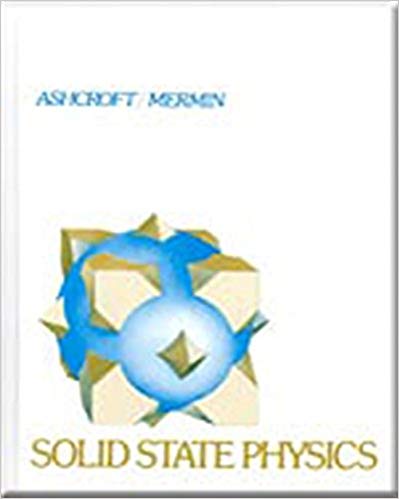 |
539.2 ASH Neil W. Ashcroft, N. David Mermin. Belmont, California :. Brooks/Cole, Cengage Learning, [1976]. Contents Preface -- Important tables -- Suggestions for using the book -- The Drude theory of metals -- The Sommerfeld theory of metals -- Failures of the free electron model -- Crystal lattices -- The reciprocal lattice -- Determination of crystal structures by x-ray diffraction -- Classification of bravais lattices and crystal structures -- Electron levels in a periodic potential: general properties -- Electrons in a weak periodic potential -- The tight-binding method -- Other methods for calculating band structure -- The semiclassical model of electron dynamics -- The semiclassical theory of conduction in metals -- Measuring the fermi surface -- Band structure of selected materials -- Beyond the relaxation-time approximation -- Surface effects -- Classification of solids -- Cohesive energy -- Failures of the static lattice model -- Classical theory of the harmonic crystal -- Quantum theory of the harmonic crystal -- Quantum theory of the harmonic crystal -- Measuring phonon dispersion relations -- Anharmonic effects in crystals -- Phonons in metals -- Dielectric properties of insulators -- Homogeneous semiconductors -- Inhomogeneous semiconductors -- Defects in crystals -- Diamagnetism and paramagnetism -- Electron interactions and magnetic structure -- Magnetic ordering -- Superconductivity. Appendices. Summary of important numerical relations in the free electron theory of metals -- The chemical potential -- The Sommerfeld expansion -- Plane-wave expansions of periodic functions in more than one dimension -- The velocity and effective mass of bloch electrons -- Some identities related to fourier analysis of periodic systems -- The variational principle for Schrödinger’s equation -- Hamiltonian formulation of the semiclassical equations of motion, and Liouville’s theorem -- Green’s theorem for periodic functions -- Conditions for the absence of interband transitions in the uniform electric or magnetic fields -- Optical properties of solids -- Quantum theory of the harmonic crystal -- Conservation of crystal momentum -- Theory of the scattering of neutrons by a crystal -- Anharmonic terms and n-phonon processes -- Evaluation of the landg-factor -- Index. Abstract This book provides a comprehensive introduction to the field of solid state physics for undergraduate students in physics, chemistry, engineering, and materials science. Subject Solid state physics 42854
|
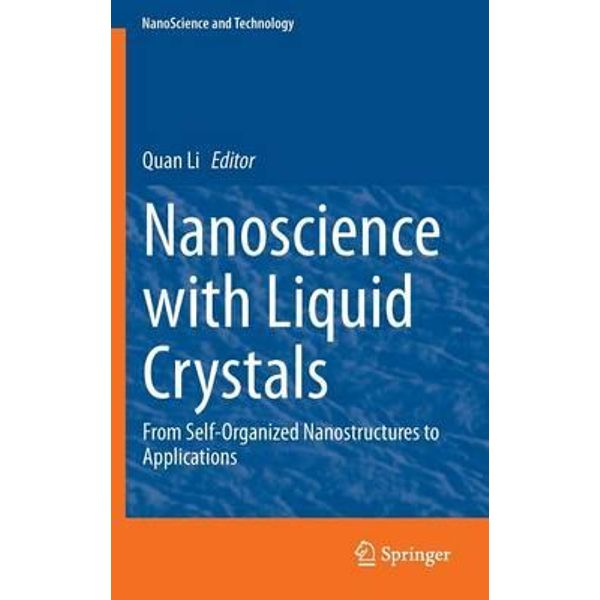 |
544.25 NAN Nanoscience with liquid crystals : from self-organized nanostructures to applications Cham : Springer, [2014]. Abstract This book focuses on the exciting topic of nanoscience with liquid crystals: from self-organized nanostructures to applications. The elegant self-organized liquid crystalline nanostructures, the synergetic characteristics of liquid crystals and nanoparticles, liquid crystalline nanomaterials, synthesis of nanomaterials using liquid crystals as templates, nanoconfinement and nanoparticles of liquid crystals are covered and discussed, and the prospect of fabricating functional materials is highlighted. Contributions, collecting the scattered literature of the field from leading and active players, are compiled to make the book a reference book. Readers will find the book useful and of benefit both as summaries for works in this field and as tutorials and explanations of concepts for those just entering the field. Additionally, the book helps to stimulate future developments. Subject Liquid crystals. Nanoscience 42894
|
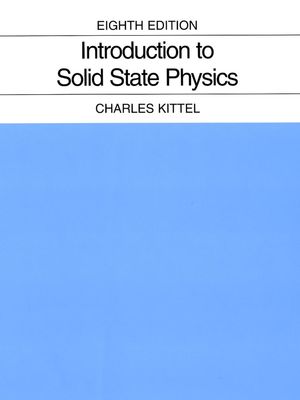 |
539.2 KIT Kittel, Charles Introduction to solid state physics / Eighth edition Hoboken, New Jersey : Wiley, [2005]. Contents 1. Crystal Structure -- 2. Wave Diffraction and the Reciprocal Lattice -- 3. Crystal Binding -- 4. Phonons I. Crystal Vibrations -- 5. Phonons II. Thermal Properties -- 6. Free Electyron Fermi Gas -- 7. Energy Bands -- 8. Semiconductor Crystals -- 9. Fermi Surfaces and Metals -- 10. Superconductivity -- 11. Diamagnetism and Paramagnetism -- 12. Ferromagnetism and Antiferromagnetism -- 13. Magnetic Resonance -- 14. Plasmons, Polarons, and Polaritons -- 15. Optical Processes and Excitons -- 16. Dielectrics and Excitons -- 17. Surface and Interface Physics -- 18. Nanostrutue Solids -- 19. Noncrystalline Solids -- 20. Point Defects -- 21. Disclocations -- 22. Alloys. Abstract Since the publication of the first edition over 50 years ago, Introduction to Solid State Physics has been the standard solid state physics text for physics students. The author’s goal from the beginning has been to write a book that is accessible to undergraduates and consistently teachable. The emphasis in the book has always been on physics rather than formal mathematics. With each new edition, the author has attempted to add important new developments in the field without sacrificing the book’s accessibility and teachability. * A very important chapter on nanophysics has been written by an active worker in the field. This field is the liveliest addition to solid state science during the past ten years * The text uses the simplifications made possible by the wide availability of computer technology. Searches using keywords on a search engine (such as Google) easily generate many fresh and useful references Subject Solid state physics 42853
|
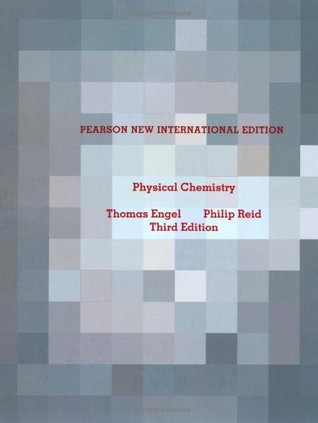 |
541.1 ENG Thomas Engel, Philip Reid. Physical chemistry / Third edition Essex : Pearson, [2014] Contents Fundamental concepts of thermodynamics -- Heat, work, internal energy, enthalpy, and the first law of thermodynamics -- The importance of state functions : internal energy and enthalpy -- Thermochemistry -- Entropy and the second and third laws of thermodynamics -- Chemical equilibrium -- The properties of real gases -- Phase diagrams and the relative stability of solids, liquids, and gases -- Ideal and real solutions -- Electrolyte solutions -- Electrochemical cells, batteries, and fuel cells -- From classical to quantum mechanics -- The Schrödinger equation -- The quantum mechanical postulates -- Using quantum mechanics on simple systems -- The particle in the box and the real world -- Commuting and non-commuting operators and the surprising consequences of entanglement -- A quantum mechanical model for the vibration and rotation of molecules -- The vibrational and rotational spectroscopy of diatomic molecules -- The hydrogen atom -- Many-electron atoms -- Quantum states for many-electron atoms and atomic spectroscopy -- The chemical bond in diatomic molecules -- Molecular structure and energy levels for polyatomic molecules -- Electronic spectroscopy -- Computational chemistry -- Molecular symmetry -- Nuclear magnetic resonance spectroscopy -- Probability -- The Boltzmann distribution -- Ensemble and molecular partition functions -- Statistical thermodynamics -- Kinetic theory of gases -- Transport phenomena -- Elementary chemical kinetics -- Complex reaction mechanisms. Abstract Engel and Reid’s Physical Chemistry provides students with a contemporary and accurate overview of physical chemistry while focusing on basic principles that unite the sub-disciplines of the field. The Third Edition continues to emphasize fundamental concepts, while presenting cutting-edge research developments to emphasize the vibrancy of physical chemistry today. Subject Chemistry, Physical and theoretical 42531
|
 |
614.253 OFR Ofri, Danielle What doctors feel : how emotions affect the practice of medicine Boston : Beacon Press, [2013]. Contents Introduction : why doctors act that way -- The doctor can’t see you now -- Can we build a better doctor? -- Scared witless -- A daily dose of death -- Burning with shame -- The doctor is overwhelmed -- Under the microscope. Abstract "By shedding light on how doctors cope with the stresses and responsibilities of patients, colleagues, lawyers, and their personal lives, she explains why it is important that patients know how emotions influence the way physicians treat their patients both medically and interpersonally. Exploring the full range of human emotion--from the fear of making a fatal mistake to the pride and elation of triumphing over death, What Doctors Feel allows patients at the other end of the stethoscope to have a good listen to the beat of the emotional life behind the white coat."--Beacon Press. Subject Attitude of Health Personnel -- Personal Narratives. Physicians -- Psychology -- Personal Narratives. Emotions -- Personal Narratives. Empathy -- Personal Narratives. Interprofessional relations -- Personal Narratives. Physician-Patient Relations -- Personal Narratives. 42868
|
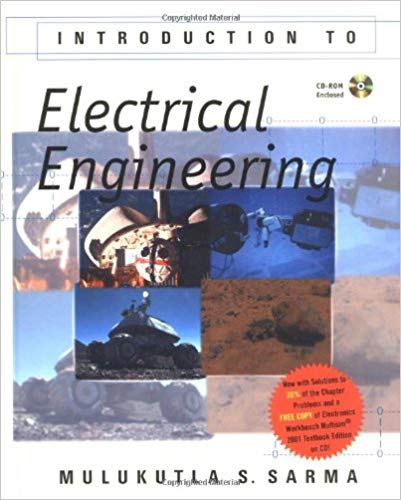 |
E SAR Sarma, Mulukutla S. Introduction to electrical engineering New York : Oxford University Press, [2001]. Contents CD-ROM contents: Complete solutions to 20% of the text problems -- Interactive example circuits -- Electronics workbench multisim V.6 student edition. Abstract "Introduction to Electrical Engineering is ideal for courses that introduce nonelectrical engineering majors to the language and principles of electrical engineering. It can also be used in undergraduate survey courses taken by electrical engineering majors." "Covering a uniquely broad range of topics, this text discusses the underlying concepts and methods behind various electrical engineering applications - from consumer gadgets and biomedical electronics to sophisticated instrumentation systems, computers, and electric machinery. Sarma highlights basic physical concepts while also emphasizing mathematical techniques, motivating students to learn the material in a logical sequence beginning with physical principles and extending to processes, modeling, using analytical techniques, and finally, designing."--Jacket. Subject Electrical engineering. 42888
|
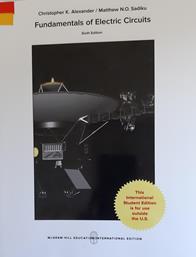 |
TB_E01 ALE Alexander, Charles K., N.O. Sadiku Fundamentals of electric circuits / Sixth edition New York : McGraw-Hill Education, [2017]. Abstract "Alexander and Sadiku’s sixth edition of Fundamentals of Electric Circuits continues in the spirit of its successful previous editions, with the objective of presenting circuit analysis in a manner that is clearer, more interesting, and easier to understand than other, more traditional texts. Students are introduced to the sound, six-step problem solving methodology in chapter one, and are consistently made to apply and practice these steps in practice problems and homework problems throughout the text."--Publisher’s website. Subject Electric circuits Operational amplifiers Capacitors Electric inductors 42890
|
|
|
E89 PLA Charles Platt and Fredrik Jansson. Encyclopedia of electronic components Sebastopol, California : Maker Media, Inc., 2013-2016. Contents V. 1. Power sources & conversion: resistors, capacitors, inductors, switches, encoders, relays, transistors -- v. 2. Signal processing : LEDs, LCDs, audio, thyristors, digital logic, amplification / Charles Platt, Fredrik Jansson -- v. 3. Sensors : location, presence, proximity, orientation, oscillation, force, load, human input, liquid and gas properties, light, heat,sound, electricity / Charles Platt, Fredrik Jansson. Abstract Want to know how to use an electronic component? This three-volume set includes key information on electronics parts for your projects -- complete with photographs, schematics, and diagrams. You’ll learn what each one does, how it works, why it’s useful, and what variants exist. No matter how much you know about electronics, you’ll find fascinating details you’ve never come across before. Perfect for teachers, hobbyists, engineers, and students of all ages, this reference puts reliable, fact-checked information right at your fingertips -- whether you’re refreshing your memory or exploring a component for the first time. Beginners will quickly grasp important concepts, and more experienced users will find the specific details their projects require. This set is unique: the first and only encyclopedia set on electronic components, distilled into three separate volumes. This set is incredibly detailed: includes information distilled from hundreds of sources. This set is instructive: each component description provides details about substitutions, common problems, and workarounds. The Encyclopedia of Electronic Components is comprehensive: Volume 1 covers power, electromagnetism, and discrete semi-conductors; Volume 2 includes integrated circuits, and light and soundsources; Volume 3 covers a range of sensing devices. Subject Electronic apparatus and appliances Detectors 42911
|
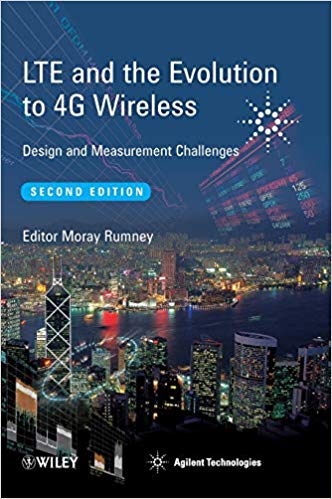 |
E91.4 LTE LTE and the evolution to 4G wireless : design and measurement challenges [England?] : Agilent Technologies, 2009 Subject Wireless communication systems Wireless Internet. Radio frequency allocation. Cell phone systems. Universal Mobile Telecommunications System Mobile communication systems Telecommunication -- Switching systems. 42929
|
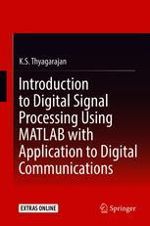 |
E91.8 THY Thyagarajan, K. S. Introduction to digital signal processing using MATLAB with application to digital communications Cham : Springer, [2019]. Contents Discrete-time signals and systems -- Z-transform -- Frequency domain representation of discrete-time signals and systems -- Discrete Fourier transform -- IIR digital filters -- FIR digital filters -- Digital filter structures -- Fast Fourier transform -- DSP in communications. Abstract This textbook provides engineering students with instruction on processing signals encountered in speech, music, and wireless communications using software or hardware by employing basic mathematical methods. The book starts with an overview of signal processing, introducing readers to the field. It goes on to give instruction in converting continuous time signals into digital signals and discusses various methods to process the digital signals, such as filtering. The author uses MATLAB throughout as a user-friendly software tool to perform various digital signal processing algorithms and to simulate real-time systems. Readers learn how to convert analog signals into digital signals; how to process these signals using software or hardware; and how to write algorithms to perform useful operations on the acquired signals such as filtering, detecting digitally modulated signals, correcting channel distortions, etc. Students are also shown how to convert MATLAB codes into firmware codes. Further, students will be able to apply the basic digital signal processing techniques in their workplace. The book is based on the author’s popular online course at University of California, San Diego. Based on the author’s popular online courses in signal processing at UC San Diego Presents an overview of signal processing, followed by easy to follow instructions without a myriad of complex mathematical derivations Enhanced by the use of MATLAB and a variety of exercises case studies, giving students hands-on experience in designing and processing signals in the digital domain. Title Sub. MATLAB Subject Signal processing -- Digital techniques. 42831
|
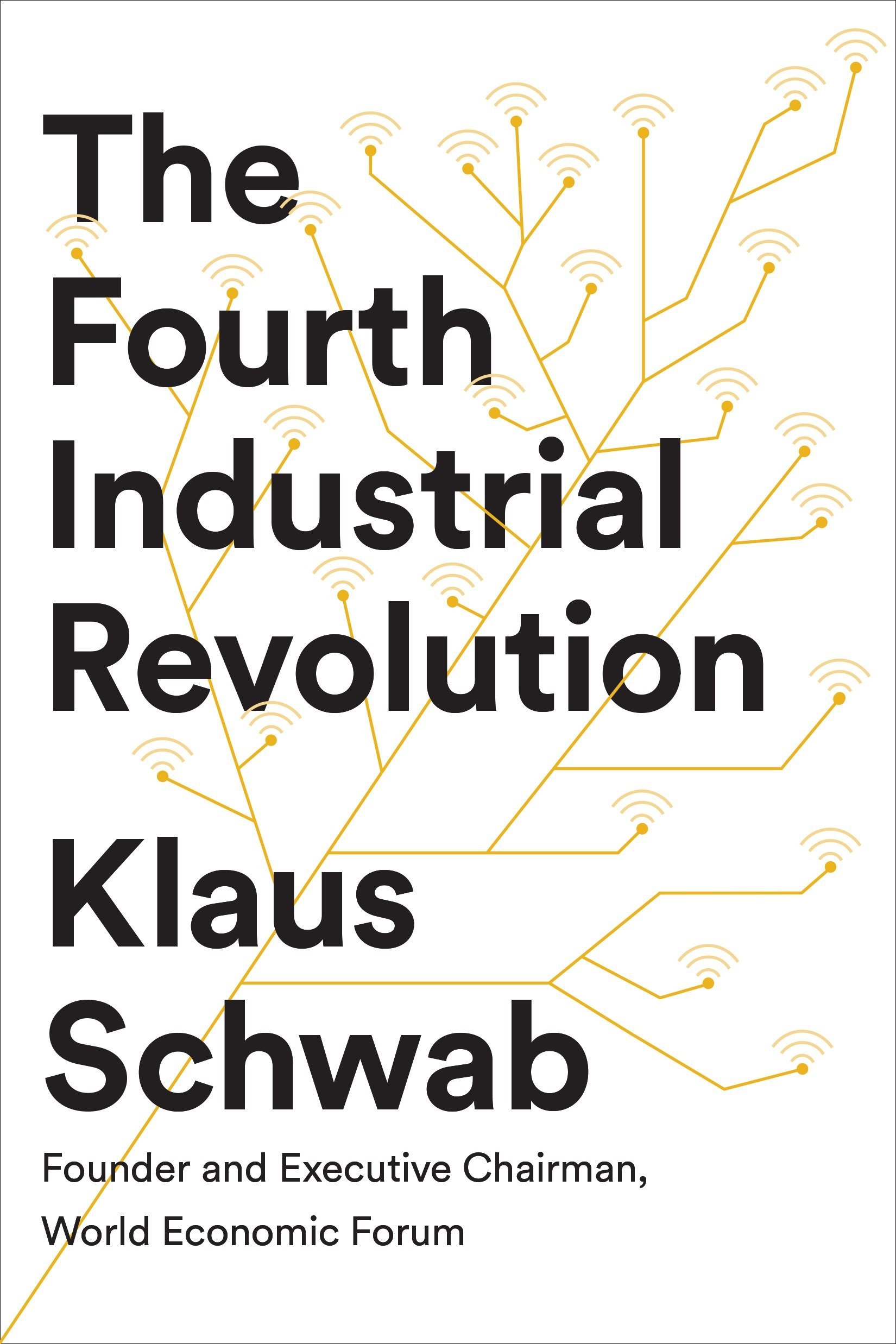 |
65.011.6 SCH Schwab, Klaus The fourth industrial revolution [London] : Portfolio Penguin, [2017]. Contents Introduction -- 1. The fourth industrial revolution. 1.1. Historical context -- 1.2. Profound and systemic change -- 2. Drivers. 2.1 Megatrends -- 2.1.1. Physical -- 2.1.2. Digital -- 2.1.3. Biological -- 2.2. Tipping points -- 3. Impact. 3.1. Economy -- 3.1.1. Growth -- 3.1.2. Employment -- 3.1.3. The nature of work -- 3.2. Business -- 3.2.1. Consumer expectations -- 3.2.2. Data-enhanced products -- 3.2.3. Collaborative innovation -- 3.2.4. New operating models -- 3.3. National and global -- 3.3.1. Governments -- 3.3.2. Countries, regions and cities -- 3.3.3. International security -- 3.4. Society -- 3.4.1. Inequality and the middle class -- 3.4.2. Community -- 3.5. The individual -- 3.5.1. Identity, morality and ethics -- 3.5.2. Human connection -- 3.5.3. Managing public and private information -- The way forward -- Acknowledgements -- Appendix: deep shift. Abstract The founder and executive chairman of the World Economic Forum on how the impending technological revolution will change our livesWe are on the brink of the Fourth Industrial Revolution. And this one will be unlike any other in human history.Characterized by new technologies fusing the physical, digital and biological worlds, the Fourth Industrial Revolution will impact all disciplines, economies and industries - and it will do so at an unprecedented rate. World Economic Forum data predicts that by 2025 we will see: commercial use of nanomaterials 200 times stronger than steel and a million times thinner than human hair; the first transplant of a 3D-printed liver; 10% of all cars on US roads being driverless; and much more besides.In The Fourth Industrial Revolution, Schwab outlines the key technologies driving this revolution, discusses the major impacts on governments, businesses, civil society and individuals, and offers bold ideas for what can be done to shape a better future for all. Subject Information technology Technological innovations -- Sociological aspects. Technological innovations -- Economic aspects. Information society. Mobile computing. Digital communications 42879
|
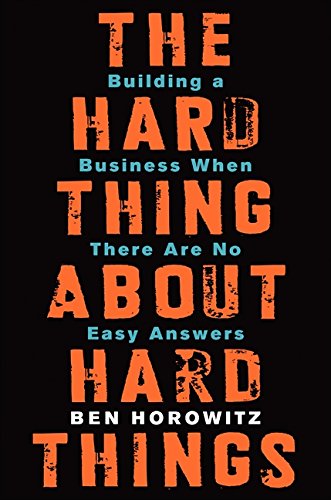 |
658.016.1 HOR Horowitz, Ben The hard thing about hard things : building a business when there are no easy answers New York : Harper Business, an imprint of HarperCollins Publishers, [2014]. Contents From communist to venture capitalist -- "I will survive" -- This time with feeling -- When things fall apart -- Take care of the people, the products, and the profits ... in that order -- Concerning the going concern -- How to lead even when you don’t know where you are going -- First rule of entrepreneurship: There are no rules -- The end of the beginning -- Appendix : Questions for head of enterprise sale force. Abstract In this book, Ben Horowitz, cofounder of Andreessen Horowitz, draws on his own story of founding, running, selling, buying, managing, and investing in technology companies to offer essential advice and practical wisdom for navigating the toughest problems business schools don’t cover. His blog has garnered a devoted following of millions of readers who have come to rely on him to help them run their businesses. A lifelong rap fan, Horowitz amplifies business lessons with lyrics from his favorite songs and tells it straight about everything from firing friends to poaching competitors, from cultivating and sustaining a CEO mentality to knowing the right time to cash in. His advice is grounded in anecdotes from his own rise -- from cofounding the early cloud service provider Loudcloud to building the successful Andreessen Horowitz venture capital firm, both with fellow tech superstar Marc Andreessen (inventor of Mosaic, the Internet’s first popular Web browser). This is no polished victory lap; he analyzes issues with no easy answers through his trials, including demoting (or firing) a loyal friend; whether you should incorporate titles and promotions, and how to handle them; if it’s OK to hire people from your friend’s company; how to manage your own psychology while the whole company is relying on you; what to do when smart people are bad employees; why Andreessen Horowitz prefers founder CEOs, and how to become one; and whether you should sell your company and how to do it. Subject New business enterprises -- Management. Entrepreneurship. Success in business 42862
|
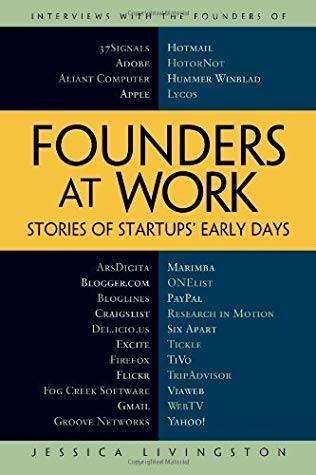 |
658.016.1(73) LIV Livingston, Jessica Founders at work : stories of Startups’ early days Berkeley, California : Apress, [2008]. Contents Max Levchin -- Sabeer Bhatia -- Steve Wozniak -- Joe Kraus -- Dan Bricklin -- Mitchell Kapor -- Ray Ozzie -- Evan Williams -- Tim Brady -- Mike Lazaridis -- Arthur van Hoff -- Paul Buchheit -- Steve Perlman -- Mike Ramsay -- Paul Graham -- Joshua Schachter -- Mark Fletcher -- Craig Newmark -- Caterina Fake -- Brewster Kahle -- Charles Geschke -- Ann Winblad -- David Heinemeier Hansson -- Philip Greenspun -- Joel Spolsky -- Stephen Kaufer -- James Hong -- James Currier -- Blake Ross -- Mena Trott -- Bob Davis -- Ron Gruner -- Jessica Livingston. Abstract For would-be entrepreneurs, innovation managers or just anyone fascinated by the special chemistry and drive that created some of the best technology companies in the world, this book offers both wisdom and engaging insights straight from the source. Chris Anderson, editor-in-chief of Wired Magazine, and author of The Long Tail "All the best things that I did at Apple came from (a) not having money and (b) not having done it before, ever". Steve Wozniak, Apple Now available in paperback-with a new preface and interview with Jessica Livingston about Y Combinator! Founders at Work: Stories of Startups’ Early Days is a collection of interviews with founders of famous technology companies about what happened in the very earliest days. These people are celebrities now. What was it like when they were just a couple friends with an idea? Founders like Steve Wozniak (Apple), Caterina Fake (Flickr), Mitch Kapor (Lotus), Max Levchin (PayPal), and Sabeer Bhatia (Hotmail) tell you in their own words about their surprising and often very funny discoveries as they learned how to build a company. Where did they get the ideas that made them rich? How did they convince investors to back them? What went wrong, and how did they recover? Nearly all technical people have thought of one day starting or working for a startup. For them, this book is the closest you can come to being a fly on the wall at a successful startup, to learn how it’s done. But ultimately these interviews are required reading for anyone who wants to understand business, because startups are business reduced to its essence. The reason their founders become rich is that startups do what businessesdo create value more intensively than almost any other part of the economy. How? What are the secrets that make successful startups so insanely productive? Read this book, and let the founders themselves tell you. Subject New business enterprises -- United States. New business enterprises -- United States -- Case studies. Electronic industries -- United States -- Case studies. 42860
|
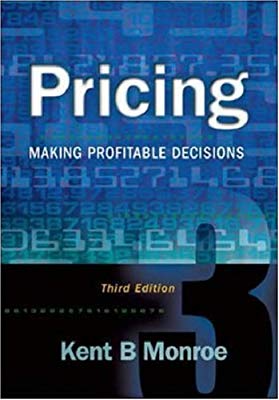 |
658.8.03 MON Monroe, Kent B. Pricing : making profitable decisions / Third edition Boston : McGraw-Hill, [2003]. Contents Ch. 1. Effective Pricing Management -- Ch. 2. The economics of Price Determination -- Ch. 3. The Economics of Information -- Ch. 4. Signaling and Managing Competition -- Ch. 5. Behavioral Foundations for Pricing Management -- Ch. 6. Pricing Practices that Endanger Profits -- Ch. 7. Price and Customer’s Perceptions of Value -- Ch. 8. Customer Value Analysis -- Ch. 9. Research Methods for Pricing Decisions -- Ch. 10. The Role of Costs in Pricing Decisions -- Ch. 11. Using Leverage for Developing Pricing Strategies -- Ch. 12. Marketing Profitability Analysis -- Ch. 13. Experience Curve Pricing -- Ch. 14. Pricing Over the Product Life Cycle -- Ch. 15. Product-Line Pricing -- Ch. 16. Developing a Price Structure -- Ch. 17. Pricing to and through the Channel -- Ch. 18. Legal Aspects of Pricing Strategy -- Ch. 19. Auctions and Competitive Bidding -- Ch. 20. Extending the Concepts of Strategic Pricing -- Ch. 21. Pricing on the Internet -- Ch. 22. Guidelines for Better Pricing Decisions. Abstract "Kent Monroe’s new edition of Pricing: Making Profitable Decisions marks the return of this classic introduction to the foundations of pricing. Designed to teach you an integrative framework for making pricing decisions, the Third Edition represents a substantial revision of the previous edition. With new topics such as price wars, value-oriented pricing, and competitive signaling incorporated into the text’s unique consumer behavior focus, this edition not only focuses on economic reasoning but it also shows you the influences and behaviors behind pricing and how companies and consumers determine the right price for a product or service." "Classroom tested and proven throughout the world in executive seminars, Pricing: Making Profitable Decisions presents clear-cut examples and provides an understandable basis for analyzing pricing alternatives within legal and corporate constraints." Subject Pricing (Marketing) 32451
|
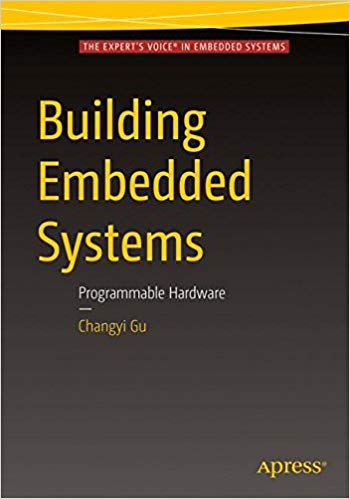 |
681.3.024 GUC Gu, Changyi Building embedded systems : programmable hardware New York : Apress, [2016]. Contents The whole picture -- Power on and bootloader -- Inside the CPU -- RAM, DMA, and interrupt -- Bus architecture -- Firmware coding in C -- Firmware coding in the C++ and script languages -- Building and deployment -- Field-programmable gate arrays -- System on programmable chip (SOPC) -- De-Bounce, power management, and display -- Fixed point math -- Popular ways of console communications : prepare the tools -- Work flow. Abstract This is a book about developing the software and hardware you never think about. We’re talking about the nitty-gritty behind the buttons on your microwave, inside your thermostat, inside the keyboard used to type this description, and even running the monitor on which you are reading it now. Subject Embedded computer systems -- Programming. 42886
|
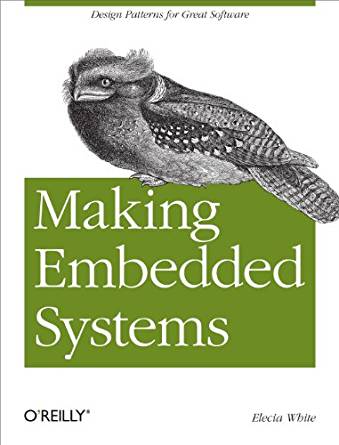 |
681.3.024 WHI White, Elecia Sebastopol, California : O’Reilly Media, [2012]. Contents Introduction -- Creating a System Architecture -- Getting Your Hands on the Hardware -- Outputs, Inputs, and Timers -- Managing the Flow of Activity -- Communicating with Peripherals -- Updating Code -- Doing More with Less -- Math -- Reducing Power Consumption Abstract Interested in developing embedded systems? Since they don’t tolerate inefficiency, these systems require a disciplined approach to programming. This easy-to-read guide helps you cultivate a host of good development practices, based on classic software design patterns and new patterns unique to embedded programming. Learn how to build system architecture for processors, not operating systems, and discover specific techniques for dealing with hardware difficulties and manufacturing requirements. Written by an expert who’s created embedded systems ranging from urban surveillance and DNA scanners to children’s toys, this book is ideal for intermediate and experienced programmers, no matter what platform you use. •Optimize your system to reduce cost and increase performance •Develop an architecture that makes your software robust in resource-constrained environments •Explore sensors, motors, and other I/O devices •Do more with less: reduce RAM consumption, code space, processor cycles, and power consumption •Learn how to update embedded code directly in the processor •Discover how to implement complex mathematics on small processors •Understand what interviewers look for when you apply for an embedded systems job Subject Embedded computer systems -- Programming. Embedded computer systems -- Design. 42887
|
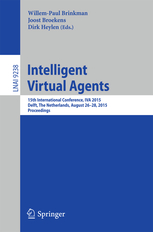 |
681.3.06 IVA IVA (Conference) (15th : 2015 : Delft, Netherlands), Cham : Springer, [2015]. Contents Adaptive dialogue and user modeling -- Cognitive, affective and social models -- Nonverbal behavior and gestures -- Pedagogical agents in health and training -- Tools and frameworks -- Turn-taking -- Virtual agent perception studies. Abstract This book constitutes the proceedings of the 15th International Conference on Intelligent Virtual Agents, IVA 2015, held in Delft, The Netherlands, in August 2015. The 11 full papers, 22 short papers, and 21 demo and poster papers accepted were carefully reviewed and selected from 70 submissions. Constructing and studying intelligent virtual agents requires knowledge, theories, methods, and tools from a wide range of fields such as computer science, psychology, cognitive sciences, communication, linguistics, interactive media, human-computer interaction, and artificial intelligence. The papers are organized in topical sections such as adaptive dialogue and user modeling; cognitive, affective and social models; nonverbal behavior and gestures; pedagogical agents in health and training; tools and frameworks; turn-taking; virtual agent perception studies. Subject Computer software Computer science Intelligent agents (Computer software) 42867
|
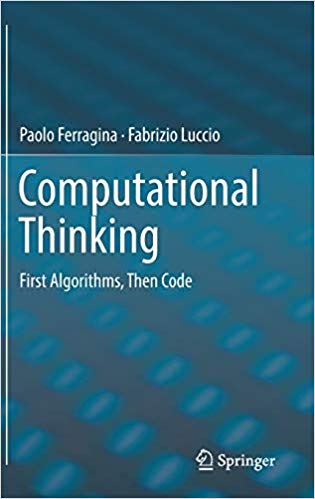 |
681.3.06:510.5 FER Paolo Ferragina, Fabrizio Luccio. Computational thinking : first algorithms, then code Cham, Switzerland : Springer, [2018]. Contents A brief historical outline -- A problem with which to begin -- Algorithms and coding -- The tournament -- A financial problem -- Secret messages -- Putting things in order -- "Easy" and "difficult" problems -- Search engines -- Data compression -- Recursion. Abstract This book offers a gentle motivation and introduction to computational thinking, in particular to algorithms and how they can be coded to solve significant, topical problems from domains such as finance, cryptography, Web search, and data compression. The book is suitable for undergraduate students in computer science, engineering, and applied mathematics, university students in other fields, high-school students with an interest in STEM subjects, and professionals who want an insight into algorithmic solutions and the related mindset. While the authors assume only basic mathematical knowledge, they uphold the scientific rigor that is indispensable for transforming general ideas into executable algorithms. A supporting website contains examples and Python code for implementing the algorithms in the book. Subject Computer algorithms Computer logic Computational learning theory. 42874
|
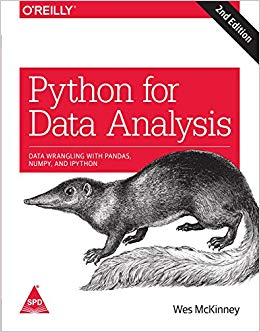 |
681.3.07.01PYTHON MCK McKinney, Wes Python for data analysis : data wrangling with pandas, NumPy, and IPython / Second edition Sebastopol, California : O’Reilly Media, Inc., [2018]. Contents Preliminaries -- Python language basics, IPython, and Jupyter notebooks -- Built-in data structures, functions, and files -- NumPy basics: arrays and vectorized computation -- Getting started with pandas -- Data loading, storage, and file formats -- Data cleaning and preparation -- Data wrangling: join, combine, and reshape -- Plotting and visualization -- Data aggregation and group operations -- Time series -- Advanced pandas -- Introduction to modeling libraies in Python -- Data analysis examples -- Advanced NumPy -- More on the IPython system. Abstract Get complete instructions for manipulating, processing, cleaning, and crunching datasets in Python. Updated for Python 3.6, the second edition of this hands-on guide is packed with practical case studies that show you how to solve a broad set of data analysis problems effectively. You’ll learn the latest versions of pandas, NumPy, IPython, and Jupyter in the process. Written by Wes McKinney, the creator of the Python pandas project, this book is a practical, modern introduction to data science tools in Python. It’s ideal for analysts new to Python and for Python programmers new to data science and scientific computing. Data files and related material are available on GitHub. •Use the IPython shell and Jupyter notebook for exploratory computing •Learn basic and advanced features in NumPy (Numerical Python) •Get started with data analysis tools in the pandas library •Use flexible tools to load, clean, transform, merge, and reshape data •Create informative visualizations with matplotlib •Apply the pandas groupby facility to slice, dice, and summarize datasets •Analyze and manipulate regular and irregular time series data •Learn how to solve real-world data analysis problems with thorough, detailed examples Subject Python (Computer program language) Programming languages (Electronic computers) Data mining 42857
|
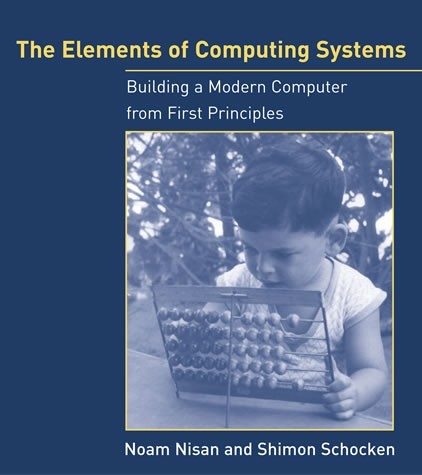 |
681.32 NIS Noam Nisan and Shimon Schocken. The elements of computing systems : building a modern computer from first principles Cambridge, Massachusetts : MIT Press, [2008]. Contents Introduction : hello, world below -- 1. $t Boolean logic -- 2. Boolean arithmetic -- 3. Sequential logic -- 4. Machine language -- 5. Computer architecture -- 6. Assembler -- 7. Virtual machine I : stack arithmetic -- 8. Virtual machine II : program control -- 9. High-level language -- 10. Compiler I : syntax analysis -- 11. Compiler II : code generation -- 12. Operating system -- 13. Postscript : more fun to go. Abstract In the early days of computer science, the interactions of hardware, software, compilers, and operating system were simple enough to allow students to see an overall picture of how computers worked. With the increasing complexity of computer technology and the resulting specialization of knowledge, such clarity is often lost. Unlike other texts that cover only one aspect of the field, The Elements of Computing Systems gives students an integrated and rigorous picture of applied computer science, as its comes to play in the construction of a simple yet powerful computer system. Indeed, the best way to understand how computers work is to build one from scratch, and this textbook leads students through twelve chapters and projects that gradually build a basic hardware platform and a modern software hierarchy from the ground up. In the process, the students gain hands-on knowledge of hardware architecture, operating systems, programming languages, compilers, data structures, algorithms, and software engineering. Using this constructive approach, the book exposes a significant body of computer science knowledge and demonstrates how theoretical and applied techniques taught in other courses fit into the overall picture. Designed to support one- or two-semester courses, the book is based on an abstraction-implementation paradigm; each chapter presents a key hardware or software abstraction, a proposed implementation that makes it concrete, and an actual project. The emerging computer system can be built by following the chapters, although this is only one option, since the projects are self-contained and can be done or skipped in any order. All the computer science knowledge necessary for completing the projects is embedded in the book, the only pre-requisite being a programming experience. The book’s web site provides all tools and materials necessary to build all the hardware and software systems described in the text, i Subject Electronic digital computers 42872
|
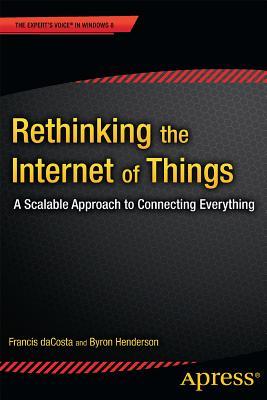 |
681.324 DAC DaCosta, Francis Rethinking the Internet of things : a scalable approach to connecting everything Berkeley, California : Apress, [2013]. Contents It’s Different Out Here -- Anatomy of the Internet of Things -- On the Edge -- Building a Web of Things -- Small Data, Big Data, and Human Interaction -- Architecture for the Frontier -- Examples and Applications -- Pathways to the Internet of Things. Abstract Over the next decade, most devices connected to the Internet will not be used by people in the familiar way that personal computers, tablets and smart phones are. Billions of interconnected devices will be monitoring the environment, transportation systems, factories, farms, forests, utilities, soil and weather conditions, oceans and resources. Many of these sensors and actuators will be networked into autonomous sets, with much of the information being exchanged machine-to-machine directly and without human involvement. Machine-to-machine communications are typically terse. Most sensors and actuators will report or act upon small pieces of information - ’chirps’. Burdening these devices with current network protocol stacks is inefficient, unnecessary and unduly increases their cost of ownership. This must change. The architecture of theInternet of Things must evolve now byincorporating simpler protocols toward at the edges of thenetwork, or remain forever inefficient. Rethinking the Internet of Things describes reasons why we must rethink current approaches to the Internet of Things. Appropriate architectures that will coexist with existing networking protocols are described in detail. An architecture comprised of integrator functions, propagator nodes, and end devices, along with their interactions, is explored. Subject Internet of things Machine-to-machine communications. Computer network protocols Computer network architectures 42859
|
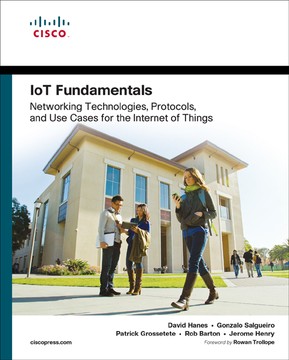 |
681.324 IOT IoT fundamentals : networking technologies, protocols, and use cases for the Internet of things Indianapolis, Indiana Cisco Press, [2017]. Contents Machine generated contents note: pt. I Introduction to IoT -- ch. 1 What Is IoT? -- Genesis of IoT -- IoT and Digitization -- IoT Impact -- Connected Roadways -- Connected Factory -- Smart Connected Buildings -- Smart Creatures -- Convergence of IT and OT -- IoT Challenges -- Summary -- References -- ch. 2 IoT Network Architecture and Design -- Drivers Behind New Network Architectures -- Scale -- Security -- Constrained Devices and Networks -- Data -- Legacy Device Support -- Comparing IoT Architectures -- The oneM2M IoT Standardized Architecture -- The IoT World Forum (IoTWF) Standardized Architecture -- Layer 1 Physical Devices and Controllers Layer -- Layer 2 Connectivity Layer -- Layer 3 Edge Computing Layer -- Upper Layers: Layers 4 -- 7 -- IT and OT Responsibilities in the IoT Reference Model -- Additional IoT Reference Models -- A Simplified IoT Architecture -- The Core IoT Functional Stack -- Layer 1 Things: Sensors and Actuators Layer -- Layer 2 Communications Network Layer -- Access Network Sublayer -- Gateways and Backhaul Sublayer -- Network Transport Sublayer -- IoT Network Management Sublayer -- Layer 3 Applications and Analytics Layer -- Analytics Versus Control Applications -- Data Versus Network Analytics -- Data Analytics Versus Business Benefits -- Smart Services -- IoT Data Management and Compute Stack -- Fog Computing -- Edge Computing -- The Hierarchy of Edge, Fog, and Cloud -- Summary -- References -- pt. II Engineering IoT Networks -- ch. 3 Smart Objects: The "Things" in IoT -- Sensors, Actuators, and Smart Objects -- Sensors -- Actuators -- Micro-Electro-Mechanical Systems (MEMS) -- Smart Objects -- Smart Objects: A Definition -- Trends in Smart Objects -- Sensor Networks -- Wireless Sensor Networks (WSNs) -- Communication Protocols for Wireless Sensor Networks -- Summary -- ch. 4 Connecting Smart Objects -- Communications Criteria -- Range -- Frequency Bands -- Power Consumption -- Topology. ch. 13 Transportation -- Transportation and Transports -- Transportation Challenges -- Roadways -- Mass Transit -- Rail -- Challenges for Transportation Operators and Users -- IoT Use Cases for Transportation -- Connected Cars -- Connected Fleets -- Infrastructure and Mass Transit -- An IoT Architecture for Transportation -- IoT Technologies for Roadways -- Bluetooth -- Cellular/LTE -- An Introduction to DSRC and WAVE -- DSRC/WAVE Protocol and Architecture -- Connected Roadways Network Architecture -- Connected Fleet Architecture -- Connected Roadways Security -- Extending the Roadways IoT Architecture to Bus Mass Transit -- Mass Transit Security -- Extending Bus IoT Architecture to Railways -- Connected Stations -- Connected Train Security -- Summary -- References -- ch. 14 Mining -- Mining Today and Its Challenges -- Scale -- Safety -- Environment -- Security -- Volatile Markets -- Challenges for IoT in Modern Mining -- The OT Roles in Mining -- Connectivity -- An IoT Strategy for Mining -- Improved Safety and Location Services -- Driver Safety -- Weather and Lightning -- Slope Monitoring -- Location Services -- Hazardous Gas Detection -- Environmental Monitoring -- Improved Efficiencies -- Improved Collaboration -- IoT Security for Mining -- An Architecture for IoT in Mining -- IEEE 802.11 as the IoT Access Layer -- 802.11 Outdoor Wireless Mesh -- 802.11 Wireless Mesh Backhaul Considerations -- Wi-Fi Clients -- Antenna Considerations for Wireless Mesh -- 4G/LTE -- Wireless in Underground Mining -- Industrial Wireless -- Isolated vs. Connected Mine Networks -- Core Network Connectivity -- Network Design Consideration for Mining Applications -- Data Processing -- Summary -- ch. 15 Public Safety -- Overview of Public Safety -- Public Safety Objects and Exchanges -- Public and Private Partnership for Public Safety IoT -- Public Safety Adoption of Technology and the IoT -- An IoT Blueprint for Public S... Abstract Today, billions of devices are Internet-connected, IoT standards and protocols are stabilizing, and technical professionals must increasingly solve real problems with IoT technologies. Now, five leading Cisco IoT experts present the first comprehensive, practical reference for making IoT work. IoT Fundamentals brings together knowledge previously available only in white papers, standards documents, and other hard-to-find sources—or nowhere at all. The authors begin with a high-level overview of IoT and introduce key concepts needed to successfully design IoT solutions. Next, they walk through each key technology, protocol, and technical building block that combine into complete IoT solutions. Building on these essentials, they present several detailed use cases, including manufacturing, energy, utilities, smart+connected cities, transportation, mining, and public safety. Whatever your role or existing infrastructure, you’ll gain deep insight what IoT applications can do, and what it takes to deliver them. •Fully covers the principles and components of next-generation wireless networks built with Cisco IOT solutions such as IEEE 802.11 (Wi-Fi), IEEE 802.15.4-2015 (Mesh), and LoRaWAN •Brings together real-world tips, insights, and best practices for designing and implementing next-generation wireless networks •Presents start-to-finish configuration examples for common deployment scenarios •Reflects the extensive first-hand experience of Cisco experts... Subject Computer networks Computer networks -- Management. Internet of things 42885
|
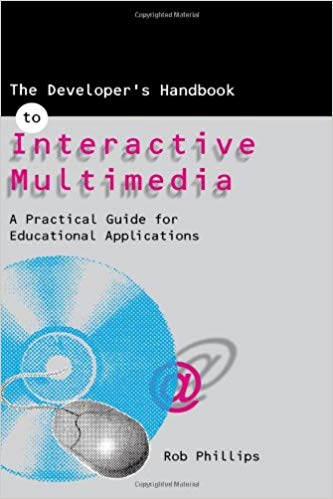 |
681.373 PHI Phillips, Rob Developer’s handbook to interactive multimedia : a practical guide for educational applications London ; Stirling : Kogan Page, [1997]. Contents 1. Interactive multimedia development -- 2. Educational considerations -- 3. A model for IMM production -- 4. Design -- 5. Development -- 6. Evaluation -- 7. Implementation and maintenance -- 8. Microbiology project case study -- 9. Dosage calculations case study -- 10. Mitochondria case study -- 11. Carbohydrates case study. Abstract New technology is being used more and more in education and providers have to be aware of what is on offer and how it can be used. This practical handbook demonstrates how interactive multimedia can be developed for educational application. Subject Interactive multimedia Educational technology 42870
|
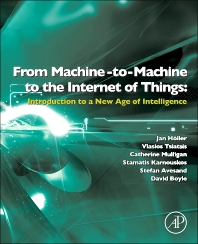 |
681.324 FRO From machine-to-machine to the Internet of things : introduction to a new age of intelligence Amsterdam : Academic Press, an imprint of Elsevier, [2014]. Contents 1. The vision for moving from M2M to IoT -- Introduction and book structure -- M2M to IoT -- the vision -- M2M to IoT -- A market perspective -- M2M to IoT -- an architectural overview -- 2. IOT Technologies and architectures -- M2M and IoT technology fundamentals -- IoT architecture -- state of the art -- Architecture reference model -- IoT reference architecture -- Real-world design constraints -- 3. IOT use cases -- Asset management -- Industrial automation -- The smart grid -- Commercial building automation -- Smart cities -- Participatory sensing -- Conclusion and looking ahead. Abstract This book outlines the background and overall vision for the Internet of Things (IoT) and M2M communications and services, including major standards. Key technologies are described: Everything from physical instrumentation devices to the cloud infrastructures used to collect data, derive information and map it to current processes, as well as system architectures and regulatory requirements. Real world service use case studies provide the hands-on knowledge needed to successfully develop and implement M2M and IoT technologies sustainably and profitably. Subject Machine-to-machine communications. Internet of things 42858
|
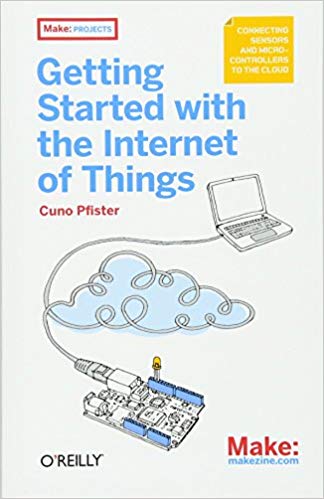 |
681.513.2 PFI Pfister, Cuno Getting started with the Internet of things : connecting sensors and microcontrollers to the cloud Sebastapool, California : O’Reilly Media, Inc., [2011]. Abstract "What is the Internet of Things? It’s countless embedded computers, sensors, and actuators all connected online. If you have basic programming skills, you can use these powerful little devices to create a variety of useful systems--such as devices that react to real-world events and take action. This hands-on guide shows you how to start building your own ... projects. Learn to program embedded devices using the .NET Micro Framework and the Netduino Plus board. Then connect your devices to the Internet with Pachube, a cloud platform for sharing real-time sensor data. ... Develop programs with simple outputs (actuators) and inputs (sensors); learn about the Internet of Things and the Web of Things; build client programs that push sensor readings from a device to a web service; create server programs that allow you to control a device over the Web; get example programs that you can compile with Visual Studio on Windows or Mono on Mac OS X and Linux" Subject Microcontrollers -- Programming. Detectors -- Design and construction. 42884
|
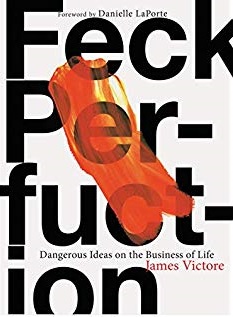 |
7.01 VIC Victore, James Feck perfuction : dangerous ideas on the business of life San Francisco : Chronicle Books, [2019]. Abstract Begin before you’re ready. Renowned designer and professional hell-raiser James Victore wants to drag you off your couch and throw you headfirst into a life of bold creativity. He’ll guide you through all the twists, trials, and triumphs of starting your creative career, from finding your voice to picking the right moment to start a project (hint: It’s now). Bring your biggest, craziest, most revolutionary ideas, and he will give you the kick in the pants you need to make them real. No matter what industry or medium you work in, this book will help you live, work, and create freely and fearlessly. Here are some dangerous ideas: • The things that made you weird as a kid make you great today. • Work is serious play. • Your ego can’t dance. • The struggle is everything. • Freedom is something you take. • There ain’t no rules. Take a risk. Try them out. Live dangerously. Subject Arts -- Psychological aspects. Arts -- Vocational guidance Creative ability Creation (Literary, artistic, etc.) Success. 42752
|
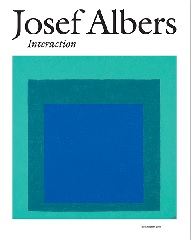 |
7.017.9(43) ALB Albers, Josef New Haven, Connecticut : Yale University Press, [2018] Contents The square in the villa / Josef Albers: Exile and emigre / Sequence and seeing: The photocollages of Joseph Albers / Activating the negative as a pedagogical method / Honesty and modesty: Josef Albers / Magical glass: On my glass pictures / The Bauhaus: Reform and innovation, at the Bauhaus / Sandblasted glass / Another take-off: Both Americas -- 1933: Farewell and future / The promised land of abstract art: Albers in Mexico / Variants: Measuring color, on painting the variants / Pre-Columbian sculptures -- Pre-Columbian art / Farbenfabeln: On the origins and development of the "Homage to the square" / Homage to the square -- Semblance and color / From the church to the plaza: Josef Albers, artist and catholic / The spiritual artist -- The silence of an icon / Influencing -- American resonances / Donald Judd on Josef Albers / "High Spring" / Looking at air: The fingerprint of Josef Albers / An illustrated biography / Abstract Features all aspects of the artist’s long career: paintings, prints, furniture, household objects, works in glass, photographs, and pre-Columbian sculptures Josef Albers (1888–1976) was one of the leading pioneers of 20th-century modernism: he was an extraordinary teacher, writer, painter, and color theorist, who is best known for the Homages to the Square (painted 1950–76) and The Interaction of Color, published by Yale University Press in 1963. This generously illustrated overview of Albers’s work, accompanying the first major exhibition on the artist in more than thirty years, features all aspects of his long, creative career. Beginning with Albers’s time at the Bauhaus in Weimar and Dessau, the publication follows the artist to America and describes major themes of his work there as well as the importance of his frequent travels to Mexico. Paintings, prints, furniture, household objects, works in glass, photographs, and pre-Columbian sculptures are beautifully reproduced and discussed by a team of experts. The juxtaposition of Renaissance sculptures and icons with paintings by Albers underlines the intellectual and spiritual dimensions of his art, and Albers’s influence on 1960s Minimalist art is also explored. Per.Sub. Albers, Josef, 1888-1976 Corp.Sub. Bauhaus Subject Painting, Abstract -- Germany -- 20th century Art, Modern -- 20th century. Modernism (Art) -- Germany -- 20th century. Optical art Glass art -- Germany -- History -- 20th century. German American artists -- 20th century 42898
|
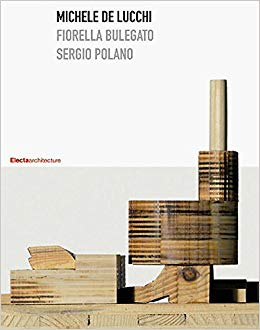 |
7.05-051(45) DEL (BUL) De Lucchi, Michele Michele de Lucchi : from here to there and beyond Milano : Electa Architecture, [2004]. Contents Just one work: designer, in general -- 1973-77 Radical architecture -- 1978-1989 the Memphis years -- 1990-99 Produzione Privata and the design of systems and services -- 2000-03 Integrated corporate design -- Appendices. Abstract Milan-based Michele de Lucchi (1951- ), architect and product designer, is known internationally for his chairs and lighting. Part of the Memphis group with Ettore Sottsass of early 1980s, de Lucchi has also had a successful career working with such international manufacturers as Artemide, Olivetti, and Vitra. This book provides a comprehensive overview of his career and documents all of his many projects to date. Also included are reprints of de Lucchis key critical writings. Per.Sub. De Lucchi, Michele, 1951- Subject Design -- Italy -- History -- 20th century. Architects -- Italy -- 20th century. Designers -- Italy -- 20th century. Industrial design -- Italy -- History -- 20th century. Architecture -- Italy -- History -- 20th century. 42803
|
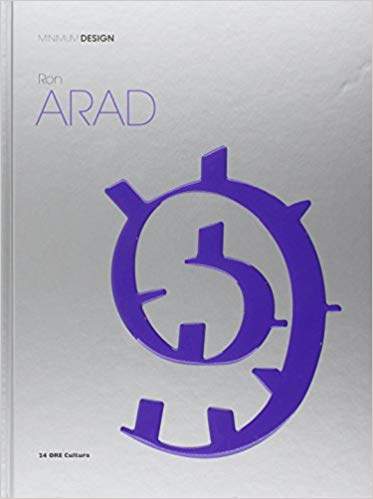 |
749.1.036(42) ARA Arad, Ron 1951- artist Pero (Milano) : ORE Cultura, [2011] Contents Ron Arad / Andrea Branzi -- A designer with no passport -- Catalogue of objects -- Objects -- Interview -- Critique Abstract The book makes light on Ron Arad carrier from the eighties to nowadays. He is the founded of One Off, his an experimental laboratory in London, and teaches design at Royal College of Art of London. Per.Sub. Arad, Ron, 1951- Subject Designers -- Israel -- 20th century. Furniture design -- History -- 20th century Installations (Art) -- 20th century. Chairs -- History -- 20th century. Chairs -- History -- 21st century. 42806
|
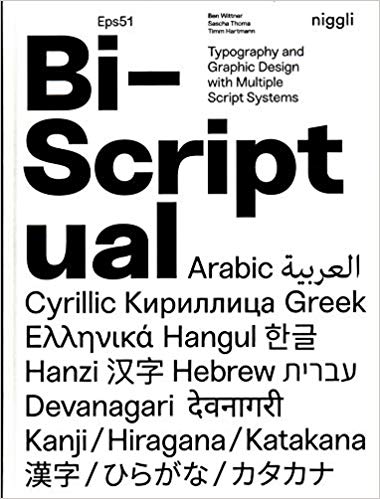 |
76.026 BIS Bi-scriptual : typography and graphic design with multiple script systems Salenstein : Niggli Verlag, [2019] Contents Foreword : Script is language is communication / Ben Wittner -- Preface : Expanding possibilities of type design today / Peter Bil’ak -- Working bi-scriptual / Huda Smitshuijzen AbiFares -- Arabic / Lara Captan, Kristyan Sarkis -- Cyrillic / Eugene Yukechev -- Devanagari / Viabhav Singh -- Greek / Gerry Leonidas -- Hangul / Jeongmin Kwon -- Hanzi / Keith Tam -- Hebrew / Liron Lavi Turkenich, Adi Stern -- Kanji/Hirangana/Katakana / Mariko Takagi. Abstract As a result of globalization and increased interaction across countries and cultures, multilingualism has gained importance. Script, as the most important conveyor of confirmation, plays a major role in this development. Designers are more and more faced with the challenge of creating designs that not only combine various languages but two or even more writing systems. At first, Bi-Scriptual discusses on a theoretical level questions such as the sociocultural relations between various writing systems and the increasing importance of sociocultural communication. Following a general section on the practical application of bilingual design, experts of the concerned languages compare eight writing systems with the Latin script. This part also contains topical interviews and practical examples of more than 100 designers. Subject Graphic design (Typography) Writing Alphabet Type and type-founding Bilingualism Multilingualism 42866 |
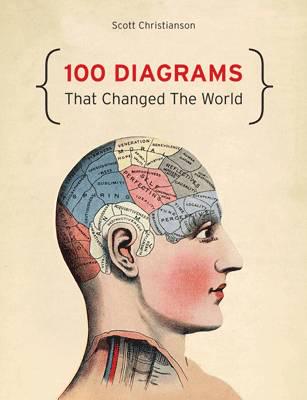 |
766(091) CHR Christianson, Scott 100 diagrams that changed the world : from the earliest cave paintings to the innovation of the iPod London : Batsford, [2014]. Abstract A fascinating collection of the most significant plans, sketches and illustrations in history From primitive cave paintings to the complicated DNA double helix drawn by Crick and Watson, these drawings chart dramatic breakthroughs in our understanding of the world and its history. Each diagram is accompanied by an explanatory text to contextualise its significance. The collection includes Da Vinci’s technical drawings, the slave ship illustration that prompted the abolition of slavery, patents by Edison, Baird and Morse, astrological charts and Copernicus’s drawing of the heliocentric universe. The perfect book for all lovers of history, science, culture and design. Subject Graphic arts -- History. Charts, diagrams, etc. -- History. Visual communication in science -- History Visual communication -- History 42897
|
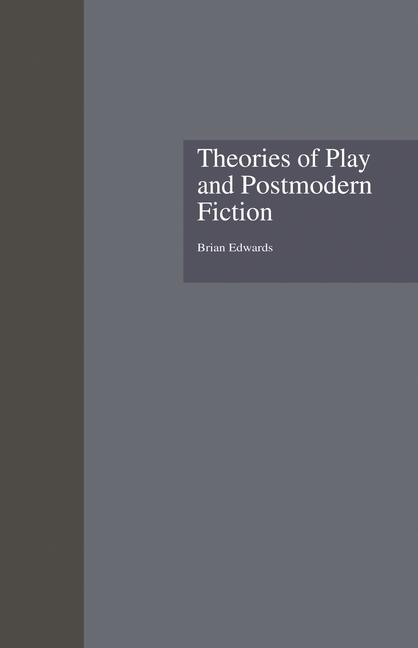 |
82 EDW Edwards, Brian Theories of play and postmodern fiction New York : Routledge, 2015. Contents Grasshopper antics: the playhouse of language. Foreplay -- Play: the reader as chameleon -- Deconstruction: the reader as Scheherazade. Duplicity as virtue: playful texts and textualized players. The play as postmoderism -- Narcissus at the edge: the endlessly diddling play of Thomas Pynchon’s Gravity’s Rainbow -- Letters to literature: the epistolary artfulness of John Barth’s LETTERS -- Strategies of influence: intertextual infiltration in Robert Kroetsch’s What the crow said -- Revisioning the carnivalesque: the cultural combinations of Angela Carter’s Nights at the circus -- Deceptive constructions: the art of building in Peter Carey’s Illywhacker. Subject Play in literature. Postmodernism (Literature) Fiction -- 20th century -- History and criticism. 42882
|
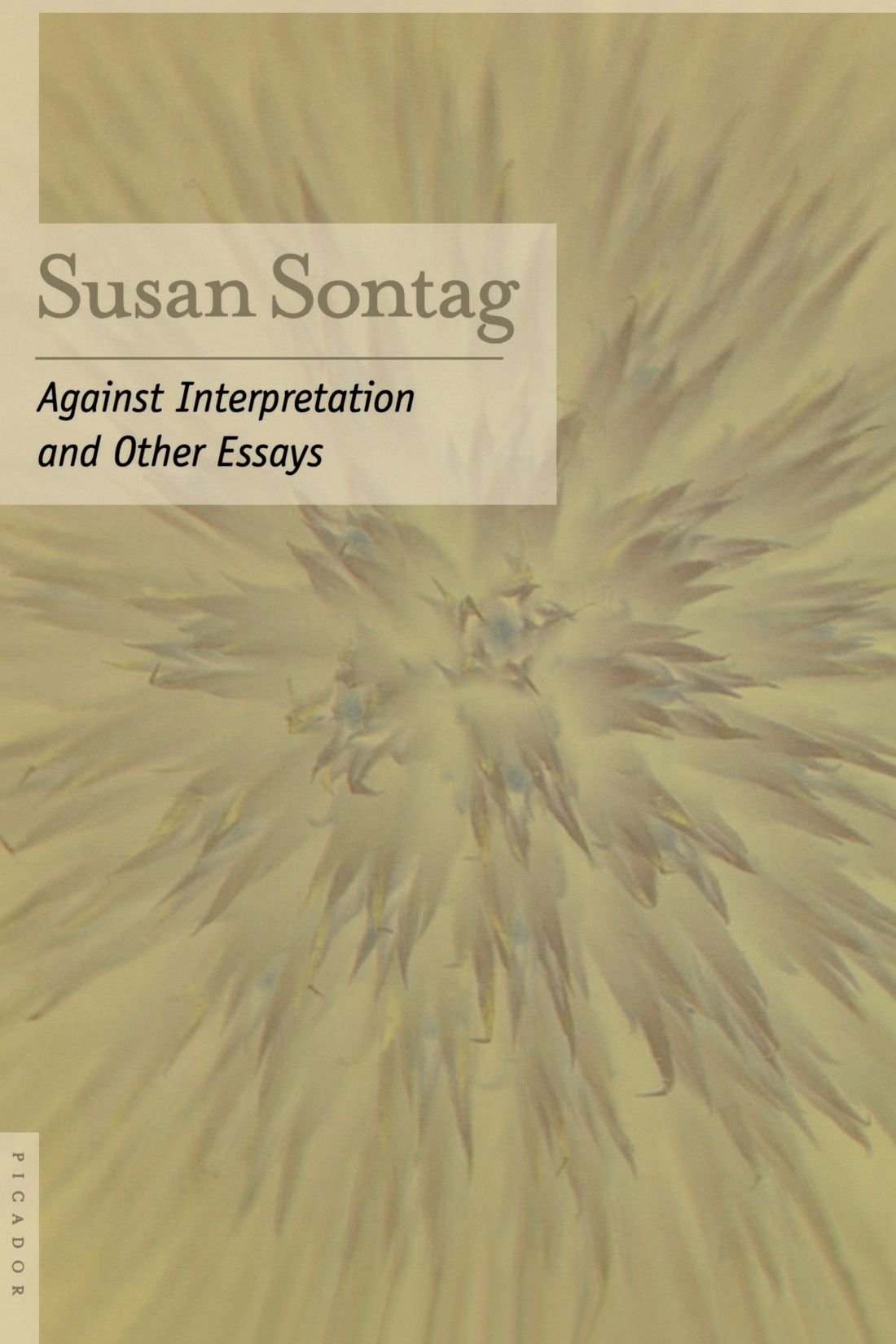 |
82 SON Sontag, Susan Against interpretation : and other essays New York : Picador/Farrar, Straus & Giroux, [1966]. Contents Against interpretation -- On style -- The artist as exemplary sufferer -- Simone Weil -- Camus’ Notebooks -- Michel Leiris’ Manhood -- The anthropologist as hero -- The literary criticism of Georg Lukács -- Sartre’s Saint Genet -- Nathalie Sarraute and the novel -- Ionesco -- Reflections on The deputy -- The death of tragedy -- Going to theater, etc. -- Marat/Sade/Artaud -- Spiritual style in the films of Robert Bresson -- Godard’s Vivre sa vie -- The imagination of disaster -- Jack Smith’s Flaming creatures -- Resnais’ Muriel -- A note on novels and films -- Piety without content -- Psychoanalysis and Norman O. Brown’s Life against death -- Happenings: an art of radical juxtaposition -- Notes on "Camp" -- One culture and the new sensibility. Abstract Against Interpretation was Susan Sontag’s first collection of essays and is a modern classic. Originally published in 1966, it has never gone out of print and has influenced generations of readers all over the world. It includes the groundbreaking essays "Notes on Camp" and "Against Interpretation," as well as her impassioned discussions of Sartre, Camus, Simone Weil, Godard, Beckett, Levi-Strauss, science-fiction movies, psychoanalysis, and contemporary religious thought. This edition has a new afterword, "Thirty Years Later," in which Sontag restates the terms of her battle against philistinism and against ethical shallowness and indifference. Subject Literature, Modern -- 20th century -- History and criticism. Criticism 42895
|
- כתבות, חדשות ואירועים



